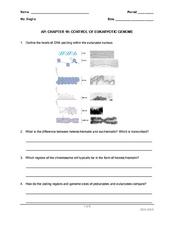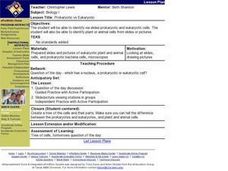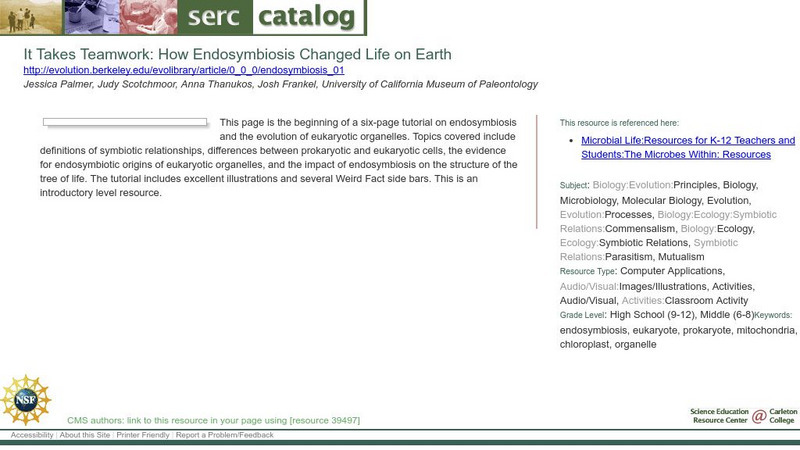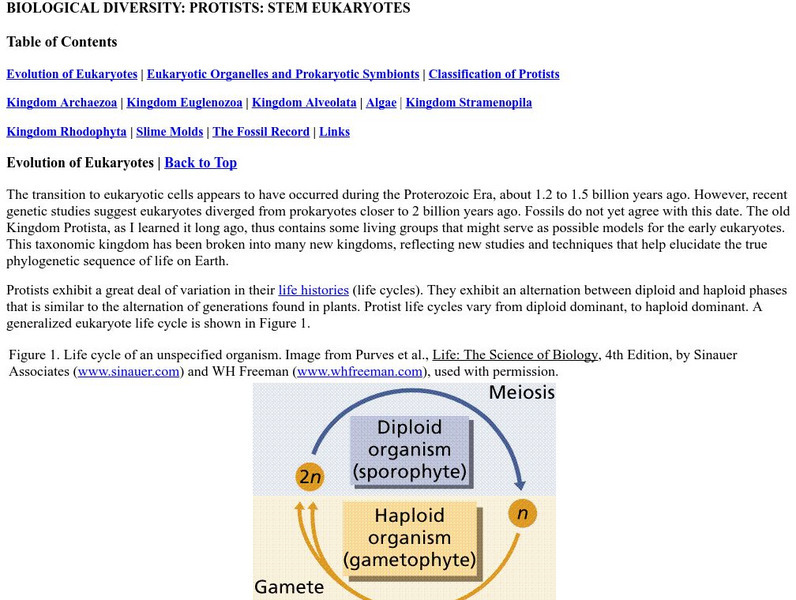Curated OER
7.012 Fall 2004 Section Self-quiz
This quiz just looks neat! It has two cell diagrams for biology class members to label. They also describe the function of each organelle. A prokaryotic and eukaryotic cell are displayed for them to compare, and then they fill in the...
Curated OER
AP: Chapter 19: Control of Eukaryotic Genome
When your AP biology class is studying DNA and genomes, this worksheet will provide a detailed review. On the first page are diagrams and matching SEM (scanning electron microscope) images of different levels of DNA packing to be...
Curated OER
Journey to the Center of a Cell
Ninth graders create a large scale model of a eukaryotic cell. In this biology instructional activity, 9th graders identify the different parts and function of the cells by using a robot to navigate through the cell models. They create a...
Curated OER
AP: Chapter 26: Origin of Life
Five pages take biologists on a generalized survey of the origin of life. Queries are made regarding theories of how life developed, ancient Earth conditions, and the ever-changing field of taxonomy. The experiments of different...
Curated OER
Cell Theory, Scientists, & Cell Types
For this cells worksheet, students compare the characteristics of eukaryotic and prokaryotic cells. Students describe how different scientists contributed to the cell theory. This worksheet has 6 short answer questions and 1 graphic...
Curated OER
Cell Growth and Division
In this biology worksheet, 9th graders identify and explain what cell stay in inter-phase. Then they describe which stage of cell is the shortest and determine why that is true. Students also explain the process of mitosis.
Curated OER
Prokaryotic vs Eukaryotic
Young scholars identify via slides prokaryotic and eukaryotic cells. They identify plant or animal cells from slides or pictures. Students are given the question of the day. They are asked which has a nucleus, a prokaryotic or...
Curated OER
Cell 4 Organelles Review
Students list and define all of the major organelles in a eukaryotic cell. They identify the correct placement of all the major organelles in a eukaryotic cell. They examine cell membrane and its function.
Cold Spring Harbor Laboratory
Dna From the Beginning: Higher Cells Have Ancient Dna
Eukaryotic cells have separate DNA from mitochondria and chloroplasts which indicates that they were once primitive cells on their own. This multimedia article includes animations, pictures, video, biographical information, and quiz...
Science Education Resource Center at Carleton College
Serc: It Takes Teamwork: How Endosymbiosis Changed Life on Earth
A tutorial on symbiotic relationships that explores the differences between prokaryotic and eukaryotic cells as well as the origins of eukaryotic organelles possibly being from endosymbiotic relationship. This tutorial also offers...
Wisc-Online
Wisc Online: Identifying Eukaryotic Animal Cell Organelles
This is a tutorial slideshow showing the internal structure of an animal eukaryotic cell. Each slide has excellent labeled drawings accompanied by descriptive text explaining the function of each part.
CK-12 Foundation
Ck 12: Biology: Prokaryotic and Eukaryotic Cells
[Free Registration/Login may be required to access all resource tools.] Instructional videos, grade-level texts, study aids, and interactive activities about prokaryotic and eukaryotic cells.
University of California
Ucmp: Introduction to the Eukaryota
The huge diversity of the Eukaryota is described, including what has been preserved in fossils. The section, "More on Morphology", explains the biology of eukaryote cells in detail.
Palomar Community College District
Wayne's Word: Comparison of Plant and Animal Cells
Students can learn about the location and the function of the major organelles in plant and animal cells. Resource includes descriptions of the functions of cell parts as well as a diagram of the two cell types.
Estrella Mountain Community College
Online Biology Book: Biological Diversity: Protists: Stem Eukaryotes
Through full-color images and descriptive information, learn about the evolution of the eukaryotic organisms which eventually led to the presence of protists.
Alabama Learning Exchange
Alex: Inside the Cell
In this lesson, students learn the different kinds of cells including plant and animal cells. They also learn how to identify and name the organelles of eukaryotic cells.
Sophia Learning
Sophia: Cell Introduction
This lesson will introduce the cell's structure and function.
CK-12 Foundation
Ck 12: Life Science: Organelles
[Free Registration/Login may be required to access all resource tools.] All organelles are found in eukaryotic cells, while most are not found in prokaryotic cells. Learn more about organelles in this learning module produced by CK-12.
Cells Alive
Cells Alive!: Plant, Animal, and Bacteria Cell Models
Find animated diagrams that describe both eukaryotic cells and prokaryotic cells. There are models for animal, plant, and bacteria cells.
Sophia Learning
Sophia: Cells: The Structural and Functional Units of Life
An illustrated presentation introducing the structure and function of the cell, including the two different types of cells: prokaryotic and eukaryotic.
BiologyWise
Biology Wise: The Structure and Functions of the Cell Membrane
This resource describes the structure and functions of the cell membrane.
BiologyWise
Biology Wise: Rough Endoplasmic Reticulum and Cell Metabolism
The characteristics of the rough endoplasmic reticulum are described and its role in protein synthesis, including creating proteins, folding them, transporting them, and checking them for quality.
Alabama Learning Exchange
Alex: Cells! Cells! Cells!
Middle schoolers will learn about both POP Art and science in this pattern project. Working in conjunction with a science teacher in your school, students will view cells through a microscope and use visual diaries to create pattern...























